On this page
- Remembering past harms, their legacy, & impact
- Preface
- Report highlights
- History of homeless services in Multnomah County 1983-2022
- Historical silos persist among systems of care for people experiencing homelessness
- The Joint Office needs to improve communication with service providers
- Poor contract management caused uncertainty and stress for providers
- The Joint Office had not communicated a strategic vision to all providers
- The Joint Office had made efforts to improve equity, but not all providers saw impacts
- Recommendations
- Objectives, scope, & methodology
- Appendix A
- Audit staff
- Related documents
Remembering past harms, their legacy, & impact
A letter from the Multnomah County Auditor
Government auditors care about context - the events and circumstances that came before and surround the issue we are assessing. Context matters because it informs how the government has functioned and been structured, and how it continues to operate. To comply with generally accepted government auditing standards, my team and I earn continuing professional education every year in topics directly related to the context in which the county government operates.
Part of the complex context for government in our nation and county includes the government's role in the displacement and genocide of Indigenous communities and the enslavement of Black people for the benefit and financial gain of Western European settlers. One of the most harmful impacts of this colonization is the loss of collective memory of many of the tribes and communities who originally lived in Multnomah County.
Our history also includes Oregon being founded as a Whites only state; the 1857 state constitution prohibited Black people from entering the state, and prevented Black people who already lived in Oregon from owning property or making contracts. It wasn't until 1925 that voters removed these exclusions. In 2002 about 30% of Oregon voters voted to keep racist language in the state constitution.
The fact that this racist language was in our state constitution as recently as 2002 underscores how the White supremacist ideas that enabled human rights atrocities are still in many ways embedded into our systems of government and the documents that prescribe how government operates. We are mindful of this context as we conduct our work; and we take responsibility for going beyond whether a government system is functioning as intended to questioning the implications of the system itself.
Acknowledging past and present harms is a first and necessary step towards change. As a government auditor, I believe that not acknowledging this history would undermine my responsibility to serve the public interest, which auditing standards define as the well-being of the community of people whom the auditor serves. Failure by government auditors to shine a light on current disparities - or failure by government officials to reduce disparities - becomes an ongoing hurt to communities who have inherited historical trauma, perpetuating mistrust of government.
To that end, we recognize that Multnomah County rests on traditional village sites of the Multnomah, Kathlamet, Clackamas, bands of Chinook, Tualatin Kalapuya, Molalla, and many other tribes who made their homes along the Columbia River, and who continue to make their homes on these ancestral lands. We also recognize that the Portland Metro area was a destination site for the Indian Relocation Act of 1956, making Multnomah County home today to the ninth largest urban Indigenous population in the United States. Our county's name, Multnomah, is derived from the Chinookan people, and we conduct daily business on unceded Indigenous soil. We also recognize that the exploitation and labor of Black and African residents helped build Multnomah County into what it is today.
Today, Multnomah County is one of many counties grappling with the heart-rending problem of homelessness. According to the National Alliance to End Homelessness, Black, Indigenous and other people of color experience homelessness at higher rates than White people. And the U.S. Department of Housing and Urban Development's 2022 Annual Homelessness Assessment stated that Black people made up just 12% of the U.S. population but accounted for 37% of people experiencing homelessness and 50% of families with children experiencing homelessness. The disparities in who experiences homelessness are largely due to historical and structural racism, and we have been mindful of this context as we conducted our audit and developed this resulting audit report.
This audit is largely about how the Joint Office manages contracts and supports providers, as well as frustrations providers have had around communication and support from the Joint Office. My team and I hope the recommendations in this audit ultimately help to create more stability, improve the efficiency and effectiveness of the work of the Joint Office and its contracted providers so that they have the capacity to address racial disparities and reduce homelessness overall.
Sincerely,
Jennifer McGuirk, MPA, CIA
Multnomah County Auditor

Approximate traditional sites of several Indigenous communities in the Multnomah County area.
Preface
A note on the context in which homeless service providers and Joint Office staff do their work
Homelessness is a crisis occurring across the United States and is a highly politicized and contentious issue. The Joint Office of Homeless Services' (Joint Office) staff do their work in the context of this charged climate. One Joint Office staff person we spoke with told us that they do not tell people where they are employed or what they do for a living because of public criticism.
During the audit, we connected with Joint Office staff through interviews and a survey that we created. Many Joint Office staff shared feedback about the challenges of dealing with public criticism amid working in a long-term crisis, including the pressure to solve the root causes of homelessness. As a Joint Office staff person who responded to our survey said,
"JOHS [Joint Office] staff and service providers are some of the most dedicated, hard working people on the planet. The man-made economic and social disaster of homelessness is 24/7 for these folks. The pandemic made it all that much harder. Homeless services are the catch-all for the failures of all of our other systems (education, healthcare, justice, human services, employment, benefits, housing, etc.), and the direct effects of racism, ableism, heterosexism, transphobia, ageism, etc. Yet homeless services departments are often blamed for not solving it. It is not JOHS sole responsibility to end the racial and economic forces that create the conditions of poverty in Multnomah County, and JOHS is often blamed for it anyway. Adequately responding to our housing crisis will require major shifts in all the systems listed above to actively address the impacts of racism and oppression. This is our collective responsibility."
We recognize the difficulty in trying to provide services within this context. Our intention is to provide critical feedback in this audit report that ultimately supports Joint Office staff and contracted providers in their work.
Report highlights
The Joint Office of Homeless Services is a partnership between Multnomah County and the City of Portland to house and shelter people experiencing homelessness. Homeless service providers told us that the Joint Office has been a confusing and chaotic organization. We talked with providers in the spring of 2022 during the planning phase of our audit, surveyed them in the fall of 2022, and interviewed representative providers in each system in 2023. Consistently across these points in time, providers reported that contract management and communication need improvements. The number of Joint Office staff has grown tremendously in the last few years and the growing pains of this expansion have been felt by both providers and staff.
What we found
- Each homeless system (adult, youth, family, domestic/sexual violence survivors, and veterans) worked in a silo with minimal communication with other systems.
- We found that the Joint Office did not consistently pay providers on time. We appreciate that staff have made their invoice review process more thorough.
- Homeless service providers expressed frustration with a lack of timely and complete contracts. Also, the Joint Office had been relying on another department for assistance.
- Program Specialists/Program Specialist Seniors have a conflict of interest; they are both the primary advocates for homeless service providers and also the ones who hold them accountable for meeting performance measures.
- Performance measures are an important way to ensure that homeless services are efficient and equitable. Staff had a lot of latitude to change performance measures when providers were unable to meet them.
- Not all homeless service providers and Joint Office staff were aware of the Joint Office's strategic vision.
- Fewer than half of homeless service providers surveyed felt the Joint Office was doing a good job communicating policies and system goals.
- Providers submitted equity plans, but Joint Office staff did not review them, which was a missed opportunity for improving equity among service providers.
What we recommend
- Joint Office management should schedule regular communication among homeless service systems.
- To improve timely payments to providers, staff should adjust their process so that they review payments in question, but do not prevent the rest of the invoice from being processed.
- Joint Office management should hire a contract management specialist to oversee the process.
- Joint Office management should modify the Program Specialist role so that this conflict of interest is eliminated.
- To ensure fairness among providers, Joint Office management should create criteria that must be met in order to change performance measures.
- Joint Office executive management needs to communicate their strategic vision.
- Joint Office management should ensure they send regular communications to service providers to address policies and goals.
- Joint Office management should ensure that Joint Office staff are trained on how to review equity plans and should review equity plans submitted by providers.
Why we did this audit
We began this audit due to concerns about the Joint Office incorrectly reporting how many people were placed in housing. We interviewed homeless service providers about their concerns related to this misreporting of data. During the course of these interviews, significant concerns about silos, communication, contract management, and strategic planning came up. We decided to expand our audit to include these issues.
We also experienced communication issues during this audit that impacted our ability to assess the reliability of the Joint Office's data. We originally requested a list from the Joint Office of all of the people included in the report Newly Placed in Housing. We wanted to conduct data quality checks. We were told by the Joint Office's data team that they didn't have access to this data and that we should speak with the System Administrator for the homeless management information system (HMIS) at the City of Portland, who runs reports for them. When we spoke with the HMIS System Administrator, they told us that they don't have the data since they run a query (data programming language to pull information) provided by the Joint Office data staff. The query produces a number, not a list of people.
We then asked the Joint Office's data team to provide us with the query they used to pull data, so we could try to recreate it. We worked to recreate their process with the data we had available to us. We met with the Joint Office data team to evaluate our analysis. The data team reviewed our work and responded by giving us a list of all of the people included in the report, Newly Placed in Housing. This was the data weâ'd originally requested and that they said they didn't have.
After months of trying to clarify our data questions with the Joint Office, we decided we would best serve the public interest by not waiting any longer on data requests and issuing two reports - this report focused on the perspectives of homeless services providers and Joint Office staff covering the period from spring 2022 through this past winter - and a second report focused on data reliability, which we will publish as soon as we can complete that work.
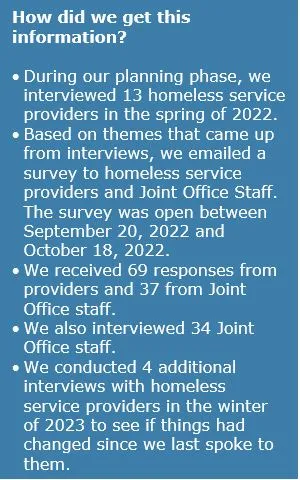
History of homeless services in Multnomah County 1983-2022
Multnomah County has grappled with how to reduce homelessness for decades. Jurisdictions across the United States are in similar positions and are facing immense public pressure to provide results. The creation of the Joint Office of Homeless Services is the most recent effort in Multnomah County to efficiently and effectively provide services to people experiencing homelessness. Below are a few key events in the history of homeless services in Multnomah County. This history is not meant to be exhaustive but rather to provide general context for the present day.
1983-1984
To better utilize resources and avoid duplicating efforts, the City of Portland and Multnomah County made an agreement, which divided responsibility for public resources. In relation to homeless services, the City of Portland agreed to manage the development of facilities, housing, and public safety projects. The County agreed to manage human services. Within this division, services for victims of domestic violence were designated to the City. Services for homeless families, adults, and youth were designated to the County.
1993
This division of responsibilities lasted 10 years until 1993 when the city and county amended the agreement. The County took responsibility for domestic violence and sexual assault survivors' services, and the City took responsibility for homeless adult services.
2005
Between 2004 and 2005, the City Council and the Board of County Commissioners launched Home Again: A 10-year Plan to End Homelessness in Portland and Multnomah County. This plan provided three strategies and nine action steps to get people housed.
3 Strategies
- Focus on the most chronically homeless populations.
- Streamline access to existing services to prevent and reduce other homelessness.
- Concentrate resources on programs that offer measurable results.
9 Action Steps
- Move people into housing first.
- Stop discharging people into homelessness.
- Improve outreach to people experiencing homelessness.
- Emphasize permanent solutions.
- Increase supply of permanent supportive housing.
- Create innovative new partnerships to end homelessness.
- Make the rent assistance system more effective.
- Increase economic opportunity for people experiencing homelessness.
- Implement new data collection technology throughout the homeless system.
2009
The federal government passed the Hearth Act, which called for:
- A change in the Department of Housing and Urban Development's (HUD) definition of homelessness and chronic homelessness
- A simplified match requirement for services
- An increase in prevention resources
- An increase in emphasis on performance
2013
The City of Portland, the county, and other community partners release an updated 10-year plan to better align with new federal funding mandates and to address new challenges, such the lagging economy from the 2008 housing crash. The plan sought better cross-jurisdictional collaboration among the county, the City of Portland, Home Forward (the housing authority of Portland), and other partners.
The plan was called A Home for Everyone: A United Community Plan to End Homelessness in Portland and Multnomah County. The plan sought to update the previous plan, Home Again: A 10-year Plan to End Homelessness in Portland and Multnomah County in order to better align with federal funding opportunities and mandates. The plan included the following principles:
- Prioritize vulnerable populations.
- Promote racial and ethnic justice.
- Use data-driven assessment and accountability.
- Engage and involve the community.
- Strengthen system capacity and increase leveraging opportunities.
According to the plan, City of Portland and Multnomah County elected officials were to convene a new governing body by July 1, 2013, which will represent jurisdictions and stakeholder groups, including government, private foundations, businesses, consumers, faith and community organizations. The governing body's responsibilities will include: a) make policy recommendations to local government and funders; b) review and develop strategies to align and maximize the effectiveness of resources; c) oversee coordination of local efforts with state and federal policies; and d) be inclusive, accountable, and transparent to the community. Funders may seek guidance from, or delegate authority to, this body to make coordinated decisions about the investment of local government dollars, private dollars, and federal funds."
Like the plan itself, this governing body was called A Home for Everyone.
2015
The City of Portland declared a one-year housing emergency which temporarily waived some building, planning, and zoning requirements for shelters. The city and county pledged $30 million collectively over the next fiscal year to increase shelter space, build affordable housing, and enforce renter protections.
The declaration has been extended since then and is currently not set to expire until 2025.
2016
The City of Portland and the county created the Joint Office of Homeless Services in order to centralize the city's and county's respective funding, policy, and planning efforts for homeless services.
Responsibilities of the office include:
- administering and monitoring contracts for services
- conducting homeless street counts and one-night shelter counts
- managing systems of care
- overseeing data system reporting and evaluation
- County oversees data for Domestic and Sexual Violence, Youth and Family systems of care
- City oversees data for Adult system of care
- Provide training and technical assistance
Services funded include:
- information, referrals, and coordinated access
- shelter
- rent assistance
- short-term and permanent supportive housing
- outreach
2020
In May 2020 Metro district area voters approved the Supportive Housing Services Measure (SHSM), which established a new personal income tax and business income tax to fund supportive housing services to prevent and reduce homelessness. Metro collects the tax dollars and Multnomah County is one of the jurisdictions that that funds are allocated to.
2022 - present
In March 2022, the first director of the Joint Office, Marc Jolin, stepped down. The governing body, A Home for Everyone dissolved in April 2022. Between 2022 and 2023, the Joint Office had two consecutive interim directors: Shannon Singleton and Joshua Bates. The Joint Office announced in April 2023 that the county had hired Dan Field as the new director.
The sudden change in the oversight body harmed the trust of some participants in the Joint Office's advisory bodies
In April 2022, A Home for Everyone dissolved. Going forward the Joint Office would be guided by internal work groups.
Some providers we interviewed told us that A Home for Everyone ended somewhat abruptly. Additionally, some providers reported that they felt the executive committee often made decisions without their input. One of these providers expressed frustration about subcommittee meetings often being cancelled. Another provider noted that sometimes A Home for Everyone's website would have outdated links to meetings. Stemming from experiences with A Home for Everyone, they expressed being skeptical of the new community advisory bodies and the impact they could have.
The new community advisory bodies provide input to Joint Office leadership, the Portland City Council, and the Board of County Commissioners. They also provide ways for community members to learn about the Joint Office and make programmatic, service, and policy recommendations. It is important to note that, unless stated otherwise, advisory committees can provide input, but not oversight.
The Joint Office's Community Advisory Bodies web page describes the different advisory committees and provides a calendar of upcoming meetings, which are open to the public:
- Equity Advisory Committee: Provides guidance and recommendations to help address racial disparities in the Joint Office's work on ending homelessness.
- Lived Experience Advisory Committee: Uplifts the voices of people who are or have been unhoused to ensure that the work of the Joint Office centers their experiences.
- Continuum of Care Board: Advises on and oversees the implementation of priorities and policies related to the Multnomah County Continuum of Care.
- Supportive Housing Services Advisory Committee: Advises Multnomah County on adherence to the Metro Supportive Housing Services Measure and the County's Local Implementation Plan and future regional plans.
- Community Budget Advisory Committee: Reviews and makes recommendations on county departmental budgets and operations.
The Joint Office developed these committees during the course of our audit. They have not completed enough work for us to audit their effectiveness.
The Joint Office experienced a significant growth in the number of employees since 2020
The growth of Joint Office has increased their capacity to meet community needs. But it also caused difficulties, such as slow response times to provider questions, as staff were busy hiring and onboarding new staff. In 2019, the Joint Office had 21 full-time equivalent (FTE) employees. Just three years later, the number of employees had grown to 106. Much of this has been due the COVID-19 pandemic and funds from the Metro Supportive Housing Bond. Recently, the number of employees has declined slightly due to COVID-19 programs ending.
The Joint Office FTE increased in recent years
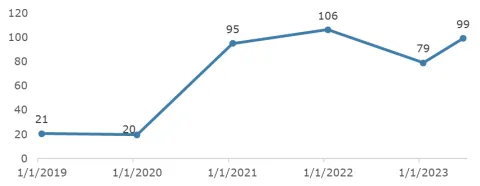
The chart above does not fully show the tremendous amount of change at the Joint Office. The chart below shows the turnover that occurred, since the Joint Office hired over 300 people and terminated (resigned, fired, limited duration position ended, etc.) over 250 employees.
The Joint Office has experienced high turnover in recent years
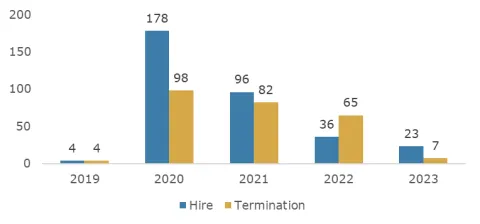
Historical silos persist among systems of care for people experiencing homelessness
Despite the fact that Multnomah County and the City of Portland created the Joint Office to centralize their funding, policy, and planning efforts for homeless services, it's still a very disjointed network. We found that the separate approaches and programs at the City of Portland and county did not merge well when the jurisdictions created the Joint Office. There continue to be silos across the systems serving people experiencing homelessness. We found poor communication by the Joint Office to be a pervasive issue, caused in part by the entrenched historical silos.
People are often required to interact with multiple systems
Individuals who are at risk of homelessness, or who are experiencing homelessness, can access services through different systems:
- Adult system
- Unaccompanied youth system
- Family system
- Domestic violence/sexual assault survivors' system
- Veterans' system
People may be eligible for services in more than one system, so they may access multiple systems at any given time. These systems originated in different jurisdictions and have different reporting processes. Several providers reported that they didn't think the Joint Office did a good job coordinating between systems.
Multiple providers expressed frustration regarding coordinated entry not working well. Each system has its own application process and assessment for coordinated access. Because clients access multiple systems, they might go through multiple application processes and have to tell their stories multiple times.
Joint Office system silos created confusion

Another contributing factor to siloing has been the inconsistency of communication across the systems.
In spring 2022 interviews, our fall 2022 survey, and in follow-up interviews in winter 2023, providers for both the adult system and the family system described inconsistencies in communication from the Joint Office based on the system they work in. For example, during the COVID-19 pandemic, a provider in the family system heard about a pay bump from COVID relief money weeks before providers in other systems. Some providers described receiving guidance from their program specialist for one of the systems, but they would not hear this guidance from the other system. Yet the guidance would be about something that both systems are involved in, such as emergency housing vouchers.
Multiple providers told us that the Joint Office didn't appear coordinated, and that there didn't seem to be coherence between these systems or within them. Additionally, one executive director said that because these systems are siloed, the Joint Office was moving further and further from countywide strategies for ending homelessness. Some providers offer services in multiple systems and noted struggles to work in multiple systems that operate separately. Our fall 2022 survey of homeless service providers echoed this sentiment, with only just over a third of providers saying that the Joint Office did a good or very good job at providing coordination between service providers.
About 1 out of 3 surveyed believe the Joint Office did a good job coordinating service providers
Survey question for homeless service providers: How well does the Joint Office do in providing coordination between service providers?
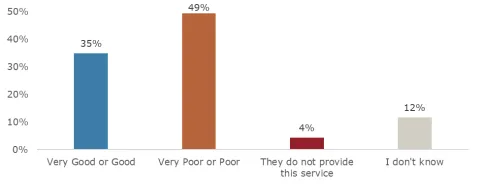
Each homeless system has different requirements for pulling data
The Joint Office had varied expectations about who is responsible for pulling data, depending on the system. Examples of data collected included: prior living situation, housing move-in date, and destination.
When the Joint Office was created, the City of Portland was responsible for overseeing data for the adult system and had providers generate their own reports in the homeless management information system (HMIS). The county was responsible for the youth, family, and domestic and sexual violence systems and had county staff pull data for those systems.
The responsibility around whether Joint Office staff or providers pull data is a holdover from how it was done prior to the creation of the Joint Office: Joint Office staff informed us that providers have continued to pull data for the adult system, Joint Office staff have pulled data for the youth and family systems, and both Joint Office staff and providers pull data for the domestic violence and sexual violence system. This method of reporting means providers working in multiple systems must manage multiple processes for reporting.
The Joint Office needs to improve communication with service providers
A number of the service providers we surveyed and interview in both the spring of 2022 and winter of 2023, noted the high turnover of staff at the Joint Office as a contributing factor for poor communication from the Joint Office. This exacerbated the communication issues stemming from each homeless system working in a silo.
Providers were frustrated with poor communication from the Joint Office
In our survey of homeless service providers, fewer than half felt that the Joint Office was doing a good job communicating policies and system goals. Less than half felt that the Joint Office did a good job at providing a contact person to answer questions quickly.
Many of the homeless service providers surveyed did not think Joint Office policies were easy to understand
Survey question for homeless service providers: How well does the Joint Office do in providing policies that are easy to understand?
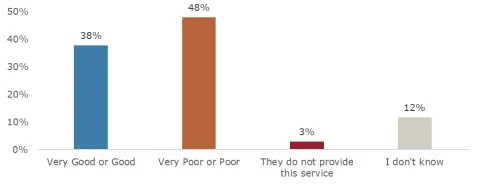
Many of the homeless service providers surveyed felt they did not have clear system goals from the Joint Office
Survey question for homeless service providers: How well does the Joint Office do in providing clear system goals?
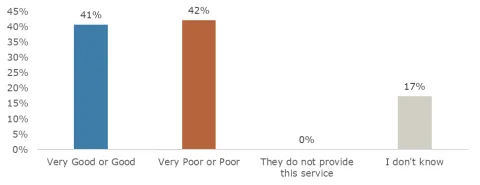
About half of homeless service providers surveyed felt they had a good contact person at the Joint Office to answer questions quickly
Survey question for homeless service providers: How well does the Joint Office do in providing a contact person at the Joint Office to answer questions quickly?
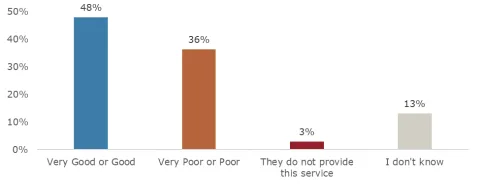
Providers described some of the ways that communication had been frustrating for them. For example, an agency we interviewed in both spring of 2022 and winter of 2023 noted that different program specialists provided their agency with different answers to the same questions. Additionally, they said that they were on a weekly call with other executive directors to discuss what they were hearing from the Joint Office, which they said was often different.
We also heard concerns when it came to coordinating providers. For example, a provider in the family system expressed frustration around the lack of coordinated communication and how it made it hard for agencies to learn from and collaborate with one another. The Joint Office did convene a monthly meeting for providers in the family system, but a provider reported to us that these meetings were often cancelled at the last minute. Another provider said in the fall 2022 survey:
"Coordination between service providers is so poor that it nearly merits as "they do not provide this service." Coordination exists only as it relates to enforcement (sweeps, clean-ups, arrests are the main topics of a weekly "Service Coordination Call") while JOHS [Joint Office of Homeless Services] does nothing that I have observed to encourage coordination between groups to improve the situation of houseless people."
Providers praised staff, but turnover and inconsistent communication from the Joint Office appeared to undermine staff efforts
In addition to the frustrations providers expressed to us, our fall 2022 survey of providers showed positive interactions with Joint Office staff, but communication was not streamlined. During the course of our audit, several Joint Office staff told us that Joint Office leadership communicated important information to service providers at the same time that staff received it. The lack of information ahead of time made it challenging for staff who were not able to answer providers' questions.
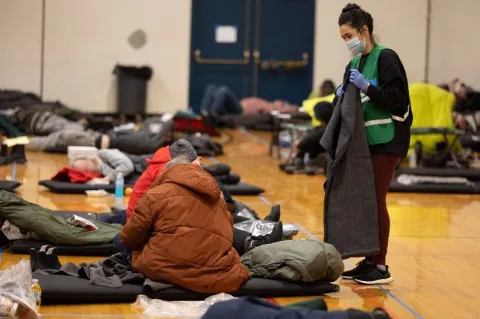
Quotes from our fall 2022 survey of providers included:
"The people we work with at JOHS [Joint Office of Homeless Services] are wonderfully dedicated and really care about us as a provider and implementer. But we have had a cascade of managers and financial contacts, receive communications and information sometimes haphazardly and it is often hard to know how and where to provide input into system planning and feedback on business issues. Better and more clear communication channels would help."
"It has been and continues to be quite difficult to communicate with the Joint Office. That is largely due to the numerous shifts in roles at JOHS, leaving us unclear about who to contact about what. For example, we were just told last week that our contract manager is changing for the second time in the past 3 months."
"Better communication and consistent communication across both Adult and Family Systems. Sometimes it depends on the staff person, some are very responsive and clearly communicate and others it is hard to get a timely response or under the process. When changes to processes change, we are not clearly notified... There is also a lot of staff turnover at the Joint Office that you don't know who is doing what role and who you need to contact for what. Access to a staff and position chart would be helpful, a visual to know who is in what position currently."
"I really appreciate the efforts that the JOHS [Joint Office of Homeless Services] has put forth to be responsive to the needs of their community partners. I would love to see continued improvements in moving towards a truly equitable collaborative partnership. But I want to acknowledge that overall, the JOHS is by far the most desirable government funder to work with in terms of responding to needs, concerns, and suggestions."
"We deeply appreciate the coordination efforts that [the youth system] has exemplified over the years."
The Joint Office has hired more staff to support providers
From 2019 to 2023, the Joint Office went from 7 contract management staff to 17. These staff are called Program Specialists or Program Specialist Seniors, and they support homeless service providers and monitor contracts. Due to the staffing increase, there has been significant energy put into training new staff. Some of this expansion occurred after our survey of service providers, so the survey comments reflect a time when the Joint Office had fewer staff.
Joint Office Staff were more positive than service providers about their office's external communication
Our survey found that Joint Office staff generally viewed their communication of policies and goals to be better than providers. When it came to doing a good job providing policies that were easy to understand, 38% of providers agreed, compared to 44% of Joint Office staff. The largest area of disagreement was whether the Joint Office was doing a good job communicating clear goals. Forty-one percent of providers agreed, in contrast with 62% of Joint Office staff. When it comes to having a good contact person, providers and Joint Office staff were nearly in agreement (48% of providers agree and 47% of staff agree).
A high percentage of Joint Office staff said they did well at providing policies that were easy to understand
Survey question for Joint Office staff: How well does the Joint Office do in providing policies that are easy to understand?
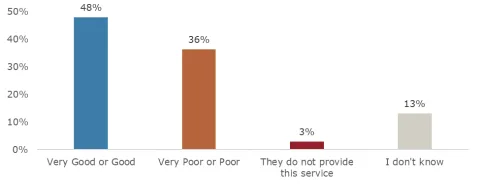
A large percentage of Joint Office staff said they were doing a good job providing clear system goals
Survey question for Joint Office staff: How well does the Joint Office do in providing clear system goals?
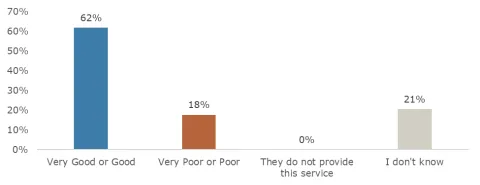
Many Joint Office staff said the office did a good job providing a contact person to service providers
Survey question for Joint Office staff: How well does the Joint Office do in providing a contact person at the Joint Office to answer questions quickly?
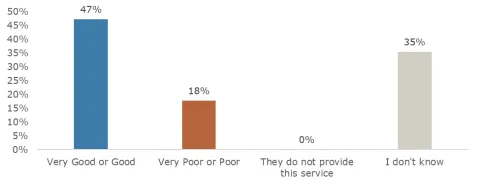
Poor contract management caused uncertainty and stress for providers
Some providers have had difficulty with contract management support
Multiple providers in both interviews and survey responses expressed gratitude for the hard work of Joint Office staff and an appreciation for the challenges they face. Despite this understanding, some providers voiced frustrations. Some quotes from the survey included:
"Observing from the outside, there are great people working there who are lovely to engage with one on one, but the culture seems highly dysfunctional. There's also a lot of "insider" culture and favoritism."
"Very confusing budgeting and contracting process this year. Need clarity and consistency. Also need to be clear that additional funds are needed and will be utilized to keep existing programs alive with a focus on staff wages. If we lose our current capacity then new programs will have no foundation to build on."
"We appreciate the efforts our grant contact makes to communcate [sic] with us but the information often changes quickly over time and is clearly out of her hands. I must say that it feels as if the finance department is running the Joint Office as the new rules, expectations, budget changes have been unruly, out of touch with the work we do and the challenges community based agencies have regarding back office capacity."
"JOHS [Joint Office of Homeless Services] is currently very disorganized with major transitions in both programmatic and fiscal support for non-profits. It takes too long to get a direct answer to a direct question."
Joint Office staff also voiced frustrations. For example, responses from the survey of staff included:
"We have the tools to create clear policies/procedures but capacity prevents us from formalizing and implementing them."
"This department is a mess. No attention is paid to the contracting or fiscal side. Program folks just go wild with plans and ideas that are not fully vetted. Too much focus on agencies that have qualified but not enough focus on suppliers with whom we actually already have contracts. Program folks want more and more contracts but they can't even handle the ones we actually already have."
The significant turnover and growth of the Joint Office staff in the last two years has impacted their contracting process. Department of County Management staff have been creating Joint Office contracts - work they don't normally do - because the Joint Office has needed the help.
Providers reported frustration with getting contract information in a timely fashion
During our spring 2022 and winter 2023 interviews, and in response to our survey, providers reported being asked to perform services without a signed contract or a contract amendment and sometimes not being compensated for services while waiting for a signed contract. For example, one provider shared that they typically didn't get their contracts until 30 or 60 days after the contracted work has started. One provider shared that in the nearly two decades in which they've been providing services and working with managing entities, the Joint Office had been the worst in terms of getting contract information out to providers.
One survey respondent said in our fall 2022 survey:
"The budgeting process is a true nightmare. I still don't have an executed contract, even with the planned delay. This is a hardship that a huge county office should not put on providers - with the reimbursement model, and not being able to invoice the entire first quarter of the year - this could be devastating to an agency to provide an "interest free loan" of sorts in order to stay operational."
Another issue that was burdensome for a provider occurred when the county issued a request for proposals for the domestic violence and sexual violence survivor system. The county used a less-than-ideal process where the county offered a six-month contract extension to providers, and then due to the procurement's challenges, offered a second six-month extension. This provider shared that this process caused them financial uncertainty and stress as to whether they would be able to continue providing services to survivors, as they budget on an annual basis, but were only guaranteed funding for six months.
Some providers reported being paid months late
Some providers reported being paid late. In some cases, they were paid months late and it impacted their ability to provide critical services. The majority of the Joint Office's payment terms are net 10, which means they should pay providers within 10 days.
It's problematic for just about any provider to wait months to be paid. Agencies typically have large monthly cash outputs for expenses such as rental assistance. One agency we spoke with had to take out a line of credit and pay interest while they waited for reimbursement from the Joint Office. Delay in payments create a hardship on service providers' cashflow, ultimately putting the populations they serve at risk.
We appreciate that the Joint Office finance team has made their invoice review process more thorough. For example, they added an invoice review process checklist for both finance and Joint Office program staff. However, we found instances of large payments being delayed in order to get documentation for small issues. For example, a provider told us about an entire large payment being held up in order to get documentation for an item that made up only a fraction of the total invoice ($25 of a $300,000 invoice). To improve timely payments to providers, Joint Office finance staff should adjust their process so that payments in question are reviewed, but do not prevent the rest of the invoice from being processed
Program Specialists could adjust performance measures in contracts when providers could not meet targets
According to a report from the National Alliance to End Homelessness and the Homelessness Research Institute, performances measures are important because they:
- Help you understand if activities are working to achieve your goals.
- Share effective techniques with other organizations.
- Instill a common understanding of what you are trying to accomplish.
In our winter 2023 interviews with Joint Office staff, some of them told us that they can modify performance measures when the providers were unable to meet them. This could be due to circumstances that are outside of the control of the provider. We recognize that circumstances change, such as during the pandemic. However, this process of readjusting performance measures should follow standard criteria and an equity lens to ensure fairness among providers. Furthermore, Program Specialists/Program Specialist Seniors have had a conflict of interest; they both the primary advocate for homeless service providers and also the ones who hold them accountable for meeting performance measures. Joint Office management should modify the Program Specialist role so that this conflict of interest is eliminated.
The Joint Office had not communicated a strategic vision to all providers
Homeless service providers had varied responses about the Joint Office's strategic vision
In our fall 2022 survey of homeless service providers, providers were split when it came to the question about the Joint Office's strategic vision.
About half of homeless service providers said that the Joint Office had a strategy for addressing homelessness
Survey question for homeless service providers: How well does the Joint Office do in providing a county-wide strategy for addressing homelessness?
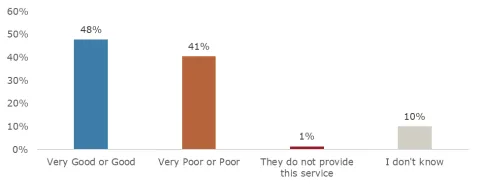
Our survey also included opportunities for written comments for the question, "What other services or structures do you think the Joint Office should provide?" The responses related to strategy are included below.
"Thought leadership on how we will end this crisis - as opposed to how we will spend the money we have to end this crisis. What is the role of the different strategies - Shelter, Rental Assistance, Structured Camps, Built PSH"
"I would like to see more opportunities for direct engagement in the strategic direction of JOHS [Joint Office of Homeless Services] and our community's work. We have no clear goals as a community. We don't adequately fund programs to drive towards the higher mission of ending homelessness, and we don't set accountability measures that are meaningful. Shelter is a broad term and we do not have any shared alignment on basic expectations for providers or what services should be required for providing shelter. In order for shelter to be dynamic, we must provide pathways out of shelter. This looks like linking resources to shelter beds, which would provide the means necessary to facilitate people exiting shelter into housing and making a bed available for the next person who needs it."
"The Joint Office should provide a process for giving feedback on the community's overall strategy to address homelessness in our community. They say that they talk to the communities and organizations doing the work, but they don't really. They come to meetings that are not well-attended to check a box to say that they got community feedback. But often the people who need to give feedback are not present in the room, and there is no strategy for outreach and engagement to ensure that folks engage in these processes."
When we spoke with homeless service providers, one organization said that there was not a clear strategy and wondered if that was because the city and county lacked agreement on direction. Another organization told us that rather than having a strategic vision, the Joint Office has been organized around different funding sources, with no coherence between them. A different organization told us that in the current political environment, everyone has had an idea about how to solve homelessness, and they would like the Joint Office to create a strategy that everyone can work toward.
Joint Office staff were more positive than providers about the strategic vision, but some had doubts
In our survey of staff, the results showed that 59% of staff felt that the Joint Office is doing a good or very good job of providing a countywide strategy, which is 11 percentage points higher than providers. It appeared that the Joint Office had done a better job communicating their strategy internally than externally.
Many staff said that the Joint Office has had a strategy for addressing homelessness
Survey question for Joint Office staff: How well does the Joint Office do in providing a county-wide strategy for addressing homelessness?
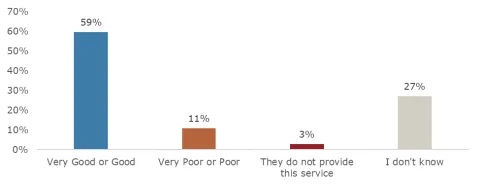
Many staff said that they did have a strategic plan and pointed to documents such as the Local Implementation Plan for the Metro Supportive Housing Services Program, created in 2020, and the A Home for Everyone strategic plan, created in 2013. But not all staff shared this view. For example, one staff person told us in December 2022, that due to changes in the director position, they were unclear about the current strategic vision for the Joint Office. Another employee told us that they did not feel that leadership has communicated a strategic vision to staff and that they were so busy reacting that there was not time to plan. Similarly, a different employee said that they were not sure if there is a strategic plan and that they were just trying to keep their team afloat.
The Joint Office had made efforts to improve equity, but not all providers saw impacts
Homeless service providers had mixed reviews of the Joint Office's equity work
In our survey of homeless service providers, we saw a wide variety of comments for the question, "Do you have any feedback about the Joint Office's practice of racial equity?"
We received 29 responses related to equity. Positive comments made up about 20% of them and they included:
"I think JOHS [Joint Office of Homeless Services] does have clear racial equity goals. I think their hiring practices and their outreach to culturally specific providers has been helpful."
"The Joint office is doing a good job in updating the agency with what is going on and how we can improve in services."
Mixed comments made up about 20% of the responses and they included:
"I do see the efforts that JOHS have been making around racial equity to look at how services are accessed and provided to ensure BIPOC communities have priority. Providing increases in COLA and wages was significant this year, it really helped us to show our staff (especially those paid the lowest) that they matter and are valued in the work they do. Doing this field of work is hard work and is not an industry that pays a lot or feels like it is valued because we underpay staff. Over and over again, other departments and higher positions require credentials, higher education, etc. that usually are more accessed by white communities. The direct service positions are often held by BIPOC people and those who are low income. If you want this work to get done, you also need to continue to increase the budgets to allow us to pay staff more and also take into consideration providers who provide a boarder range of services beyond JOHS and still doing the work of helping our communities thrive."
"I believe JOHS [Joint Office of Homeless Services] values racial equity and seeks to drive programs towards equitable service delivery. We were told there was an equity analyst assigned to shelters, yet we never heard from this person or received any directive or engagement on how they could support programs...We should be elevating the work of culturally-specific providers while also increasing the knowledge, best practices, and accountability for non-culturally-specific agencies."
Negative comments made up more than half of the responses and they included:
"Decisions are made all the time without any reference to the equity lens. I have definitely experienced inequities in getting support from the Joint Office. It depends on who you know. If you know the people in power and feel comfortable reaching out directly to them to get resources, it's great. But if you don't realize you can do that or you are from a background that doesn't make it easy to just approach a position of power and ask for resources, then you get ignored and looked over."
"No, it does not even fund positions fully... How are we supposed to attract and sustain BIPOC staff when everything is piece meal. And we still cannot provide a living wage in the city. JOHS should have a minimum of $23.73 (in 2021, so likely higher now) to allow folks' it contracts with to at least be able to afford a one bedroom apartment. Otherwise you are putting staff in direct "competition" with the populations you aim to serve."
The Joint Office has hired more equity staff
Recently, the Joint Office hired more staff to coordinate equity work. Our survey took place when they had three equity staff and now they have six. When we spoke with equity staff, they talked about their work with culturally specific providers on capacity building and creating an equity lens.
Joint Office staff had a more positive perspective on their equity work
We also surveyed staff at the Joint Office about the department's equity work, and their responses tended to be more positive than homeless service providers.
Positive comments made up about 60% of the responses and they included:
"JOHS [Joint Office of Homeless Services] meetings have standing agendas to discuss using our racial equity lens tool and bringing real scenarios and running them through the tool. Yes, the Joint Office's strategy includes a huge focus on racial equity and most decision points are made through this lens."
"JOHS has just implemented a new tool for addressing racial equity and is the process of building strong internal structure."
"The JOHS is ahead of the curve in this area in comparison to the rest of the county. The JOHS was among the first of the departments to create and implement a racial equity tool, and has been requiring service providers to show their work on racial equity year over year. The JOHS is staffed primarily by people who care deeply about this subject and most of our meetings contain at least one equity-related agenda item."
Mixed comments made up 14% of the responses and they included:
"Racial equity is a clear value of the Joint Office, both internally and in service provision. Recognizing that many of the newer and smaller organizations the JOHS [Joint Office of Homeless Services] is contracting with are culturally specific organizations, TA provisions needs to be emphasized. It would also be helpful for the JOHS/County to offer more trainings and support for white-dominant and white-led organizations to work on racial equity more deeply."
Negative comments made up 27% of the responses and they included:
"Much of the office's strategy for racial equity falls on program team staff without much support or direction. Other departments should be held to the same standards with our providers. More work should be done to align the City with our racial equity goals."
We also spoke with staff and heard many of the same themes that occurred in the survey. One person told us that unlike previous organizations they had worked for, the Joint Office was sincere in their equity work. For example, at a meeting they used an equity lens to determine how to distribute supplies. The employee was pleased that the equity lens was used for practical purposes, rather than being theoretical. Several others echoed this and said that they use the equity lens for decision making. Another person we spoke with said that the equity efforts from the Joint Office are performative. They also said that the Joint Office is steeped in white dominant culture, which requires staff to document everything and that takes up a lot of time that could be better spent supporting providers.
Joint Office staff did not review equity plans submitted by providers
The Joint Office requires homeless service providers to submit equity plans. However, staff told us in December 2022 interviews that they did not review the plans due to their busy schedules or because they have not been provided with any guidance on how to review equity plans.
Recommendations
1. To reduce the planning and communication barriers that silos cause, Joint Office management should schedule regular communication between homeless service systems, including both Joint Office staff and homeless service providers. Due date: January 1, 2024
2. We appreciate that the finance team has made their invoice review process more robust. However, we found instances of large payments being delayed in order to get documentation for small issues. To improve timely payments to providers, Joint Office finance staff should adjust their process so that the payments in question are reviewed, but do not prevent the rest of the invoice from being processed. Due date: June 1, 2024
3. To ensure that providers receive timely and complete contracts and contract amendments, Joint Office management should hire contract management specialists to oversee the process so that the Joint Office does not have to rely on an outside department for assistance. Due date: June 1, 2024
Auditor's note: The Auditor's Office met with county and Joint Office leadership to discuss this audit report on August 2, 2023. At that time, leadership agreed with this recommendation. In their response letter, which follows this report, Chair Vega Pederson, COO Cruz, and Joint Office Director Field stated that this recommendation had been met in June 2023. The Auditor's Office did not receive information about this at or before the August 2 meeting, or before receiving the response letter, and has not received or evaluated any evidence related to management's assertion.
4. Program Specialists/Program Specialist Seniors have a conflict of interest in being both the primary advocate for homeless service providers and also the ones who hold them accountable for meeting performance measures. Joint Office management should modify the Program Specialist role so that this conflict of interest is eliminated. Due date: January 1, 2024
5. Performance measures are an important way to ensure that money spent on homeless services are efficient and equitable. Currently, staff have a lot of latitude to change performance measures when providers are unable to meet them. Joint Office management should create criteria that must be met in order to change performance measures to ensure fairness among providers. Due date: June 1, 2024
6. Not all homeless service providers and Joint Office staff are aware of the Joint Office's strategic vision. The Joint Office executive management needs to communicate their strategic vision to providers and staff. Due date: January 1, 2024
7. Fewer than half of homeless service providers surveyed felt the Joint Office was doing a good job communicating policies and system goals. Joint Office management should ensure they send regular communications to service providers to address policies and goals. Due date: January 1, 2024
8. Currently, providers submit equity plans, but Joint Office staff do not review them, which is a missed opportunity for improving equity among service providers. Joint Office management should train staff on how to review equity plans and have them to review equity plans submitted by providers. Due date: June 1, 2024
Objectives, scope, & methodology
The objectives of this audit were to:
- Determine if the Joint Office is providing useful and clear guidance to contracted providers
- Determine how the Joint Office collects and uses data to measure system performance
To accomplish these objectives, we:
- Reviewed guidance from the U.S. Department of Housing and Urban Development and other federal agencies
- Researched history of homeless services in Multnomah County and the City of Portland
- Reviewed Joint Office budget documents and performance measures
- Interviewed 14 homeless service providers; most in the spring of 2022 and with four of them in the winter of 2023 (each from a different homeless system)
- Based on themes that came up from the spring 2022 interviews, we emailed a survey to 45 homeless service providers in the fall of 2022
- We encouraged provider management to forward the survey to all staff in their organization; we received 69 responses
- Sent a survey to Joint Office staff in the fall of 2022 using the same questions we sent to providers; 37 staff responded
- Interviewed 34 Joint Office staff during the course of the audit.
We conducted this performance audit in accordance with generally accepted government auditing standards. Those standards require that we plan and perform the audit to obtain sufficient, appropriate evidence to provide a reasonable basis for our findings and conclusions based on our audit objective. We believe that the evidence obtained provides a reasonable basis for our findings and conclusions based on our audit objectives.
Appendix A
The Multnomah County Auditor's Office has conducted a number of audits of homeless services in recent years
2015: Community Services Division Housing Assistance for Vulnerable Families
In 2015, we released an audit of housing assistance for vulnerable families, which at the time was managed by the Department of County Human Services' (DCHS) Community Services Division.
Audit Findings:
- Many programs used best practices to prevent homelessness
- The system of programs is complex, making it difficult track program costs and system performance, including how well different systems of care were operating together to support clients
- Data could be used more efficiently for decision making
- Demand for services exceeded supply
Summary of Recommendations:
- Provide transparency by describing individual Community Services programs and how they work together to provide services to vulnerable families. Consider developing an online dashboard to describe programs and provide regular reports on program performance.
- Analyze data to illuminate the characteristics of client populations and to better understand why some clients are successfully stabilized into housing and others are not.
2018: Joint Office of Homeless Services: Effectiveness and Accountability in its first year
We audited the Joint Office in its first year to:
- Identify where the combined Joint Office dollars were targeted and if increased reliance on service providers exposed the county to additional risk.
- Determine whether the system performance information being provided to leadership, stakeholders, and taxpayers is useful, transparent, and based on complete data
Auditing Findings:
- Joint Office staff were dedicated and hardworking, with years of experience and a passion for their work
- The county was reliant on a limited number of providers in certain service areas
- The Joint Office lacked full evaluation and analytical capacity and did not have full access to complete source data
- The Joint Office did not communicate with stakeholders and the public about the performance of the homelessness system as frequently and extensively as needed
Summary of Recommendations:
- Work with the Homeless Management Information System (HMIS) administrator at the City of Portland to gain full access to data
- Build in capacity for analysis and evaluation
- Regularly report to the public on system performance, targets and results.
- Work with service providers to improve data collection efforts, particularly at the shelter level.
- Consider contractor financial stability, contractor reliance on County revenue, and County reliance on contractor services when determining risk mitigation activities when entering into new contract relationships.
2020: Accessing Housing and Homeless Services Informational Report
In 2019, we began an audit on accessing housing and homeless services. County Auditor Jennifer McGuirk suspended the audit in 2020 in order to avoid distracting from the County's response to the COVID-19 pandemic. We instead used the information gathered to create an informational report that provided an overview of the Joint Office and shared themes from about 40 interviews.
Themes:
- Services were in high demand, making assistance hard to obtain
- Staff at nonprofit providers were paid low wages, leading to turnover (and housing insecurity among some staff).
- The coordinated access process, which uses a vulnerability assessment tool to determine who to prioritize for available housing assistance, intends to prioritize the most vulnerable people - but:
- the process can be complicated,
- it may take a long time for people to actually receive assistance, and
- the assessment process may disadvantage some people of color, non-English speakers, and households from immigrant and refugee communities.
2021: Audit of living conditions for clients of county-funded housing services
We began an audit focused on the health and safety of permanent housing placements funded by the Joint Office. We determined that the Joint Office's data from the Homeless Management Information System (HMIS) did not support the number of permanent housing placements they reported for FY 2020 and FY 2021.
We also found that the Joint Office had been reporting the date individuals enrolled in permanent housing programs as the date they entered permanent housing, which are not necessarily the same thing.
Because the data was not reliable for purposes of the audit, Auditor McGuirk ended the audit, communicated the problems to management, and initiated an audit focused on Joint Office information systems - this audit.
Audit staff
Nicole Dewees, MBA, CIA, Audit Director
Mandi Hood, MA, Management Auditor
